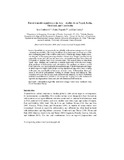Forest transition pathways in Asia - studies from Nepal, India, Thailand, and Cambodia

Date
2011-06-03Author
Southworth, J.
Nagendra, H.
Cassidy, L.
Publisher
Taylor & FrancisType
Published ArticleMetadata
Show full item recordAbstract
Tropical forest habitat continues to decline globally, with serious consequences for environmental sustainability. The South/Southeast Asian landscapes represent one of the most challenging parts of the world to study issues of landscape change. High population densities in the region pose major threats to forest cover. Despite presentations of supposedly catastrophic declines in forest cover, substantial areas have been observed to maintain or increase forest cover in recent years. This research draws on data from Nepal, India, Thailand, and Cambodia to examine trajectories of forest-cover change along gradients of deforestation and reforestation. The gradients we observe extend from Cambodia, a still predominantly forested landscape, with development and change at initial stages, to Nepal which, despite having experienced large-scale forest clearing in the past, has considerable reforestation in recent years. Understanding these processes is critical for policymakers working on climate change and adaptation. This research allows us to link national-scale and local-scale analyses, in terms of both their similarities and differences, and also to see changes still in progress via the inclusion of regrowth and degradation classes, not just reforestation and deforestation.
Collections
- Research articles (ORI) [270]
